Clinical Handover: Importance, Practices, and Recommendations
VerifiedAdded on 2022/08/23
|13
|3409
|15
Report
AI Summary
This report delves into the critical topic of clinical handover in healthcare, defining it as the transfer of medical responsibility and information. It emphasizes the significance of effective communication and the sharing of medical records to ensure patient safety and quality of care. The report identifies key themes, including the importance of clinical handover in nursing, the need for improved handover practices, and the adverse effects of poor communication. It highlights the role of standardized processes and clinical handover programs in enhancing patient outcomes. The report also provides recommendations for improving clinical handover among healthcare professionals, addressing issues such as lack of formal frameworks and inadequate documentation. The discussion analyzes studies and provides insights into the current state of clinical handover practices, emphasizing the need for continued improvement through education and the implementation of evidence-based strategies. The report highlights the importance of organizational and environmental factors on effective handoffs and the use of technology.
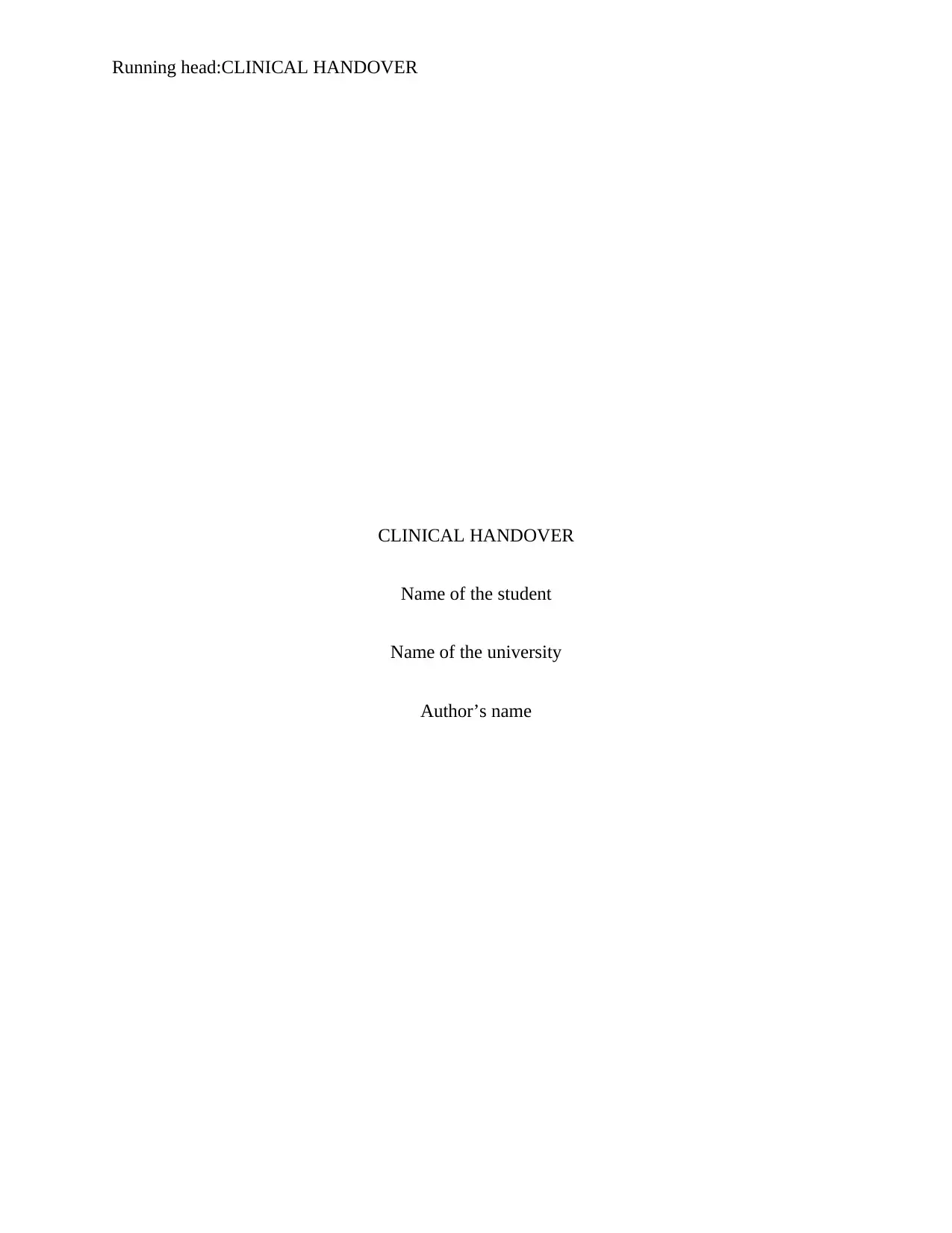
Running head:CLINICAL HANDOVER
CLINICAL HANDOVER
Name of the student
Name of the university
Author’s name
CLINICAL HANDOVER
Name of the student
Name of the university
Author’s name
Paraphrase This Document
Need a fresh take? Get an instant paraphrase of this document with our AI Paraphraser
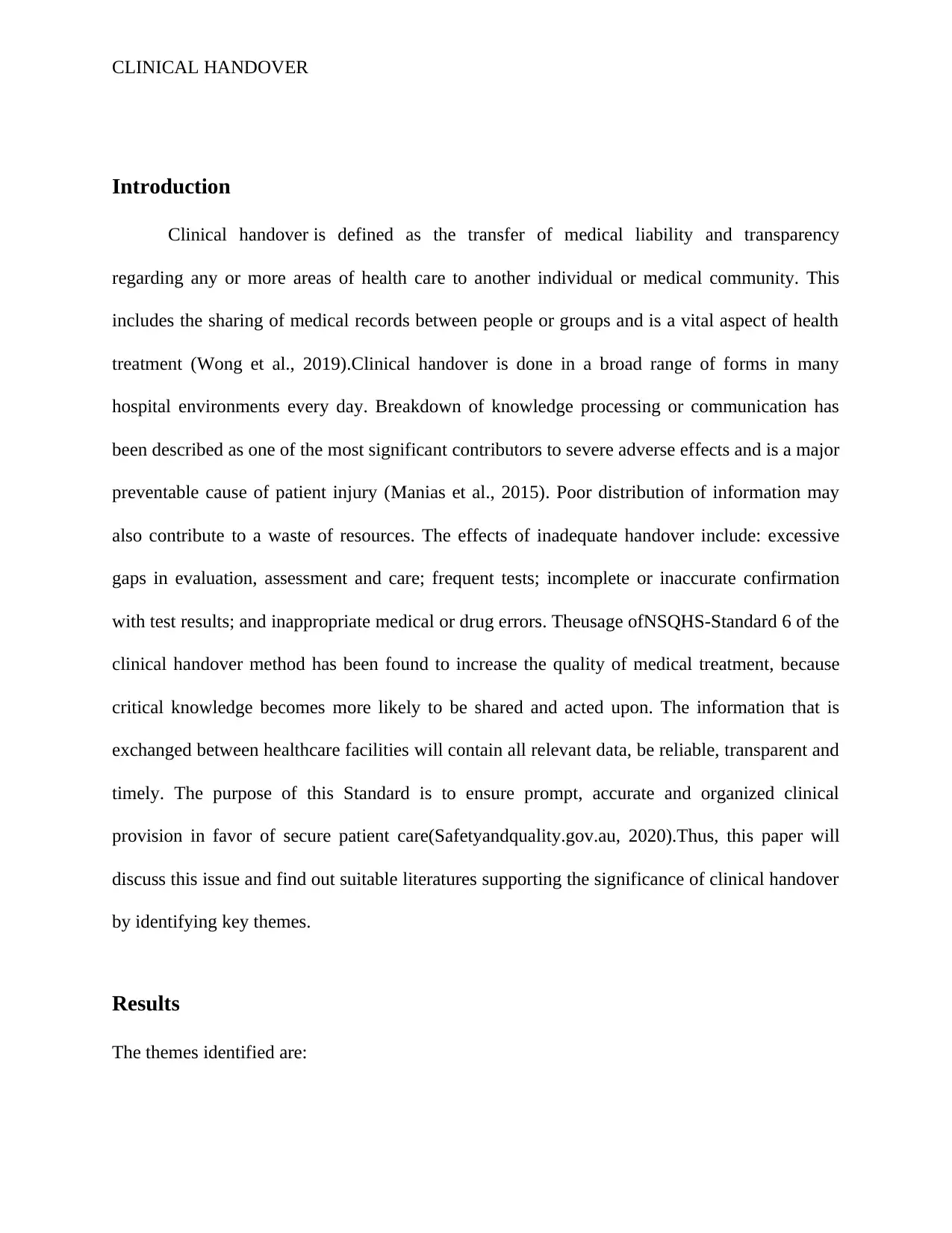
CLINICAL HANDOVER
Introduction
Clinical handover is defined as the transfer of medical liability and transparency
regarding any or more areas of health care to another individual or medical community. This
includes the sharing of medical records between people or groups and is a vital aspect of health
treatment (Wong et al., 2019).Clinical handover is done in a broad range of forms in many
hospital environments every day. Breakdown of knowledge processing or communication has
been described as one of the most significant contributors to severe adverse effects and is a major
preventable cause of patient injury (Manias et al., 2015). Poor distribution of information may
also contribute to a waste of resources. The effects of inadequate handover include: excessive
gaps in evaluation, assessment and care; frequent tests; incomplete or inaccurate confirmation
with test results; and inappropriate medical or drug errors. Theusage ofNSQHS-Standard 6 of the
clinical handover method has been found to increase the quality of medical treatment, because
critical knowledge becomes more likely to be shared and acted upon. The information that is
exchanged between healthcare facilities will contain all relevant data, be reliable, transparent and
timely. The purpose of this Standard is to ensure prompt, accurate and organized clinical
provision in favor of secure patient care(Safetyandquality.gov.au, 2020).Thus, this paper will
discuss this issue and find out suitable literatures supporting the significance of clinical handover
by identifying key themes.
Results
The themes identified are:
Introduction
Clinical handover is defined as the transfer of medical liability and transparency
regarding any or more areas of health care to another individual or medical community. This
includes the sharing of medical records between people or groups and is a vital aspect of health
treatment (Wong et al., 2019).Clinical handover is done in a broad range of forms in many
hospital environments every day. Breakdown of knowledge processing or communication has
been described as one of the most significant contributors to severe adverse effects and is a major
preventable cause of patient injury (Manias et al., 2015). Poor distribution of information may
also contribute to a waste of resources. The effects of inadequate handover include: excessive
gaps in evaluation, assessment and care; frequent tests; incomplete or inaccurate confirmation
with test results; and inappropriate medical or drug errors. Theusage ofNSQHS-Standard 6 of the
clinical handover method has been found to increase the quality of medical treatment, because
critical knowledge becomes more likely to be shared and acted upon. The information that is
exchanged between healthcare facilities will contain all relevant data, be reliable, transparent and
timely. The purpose of this Standard is to ensure prompt, accurate and organized clinical
provision in favor of secure patient care(Safetyandquality.gov.au, 2020).Thus, this paper will
discuss this issue and find out suitable literatures supporting the significance of clinical handover
by identifying key themes.
Results
The themes identified are:
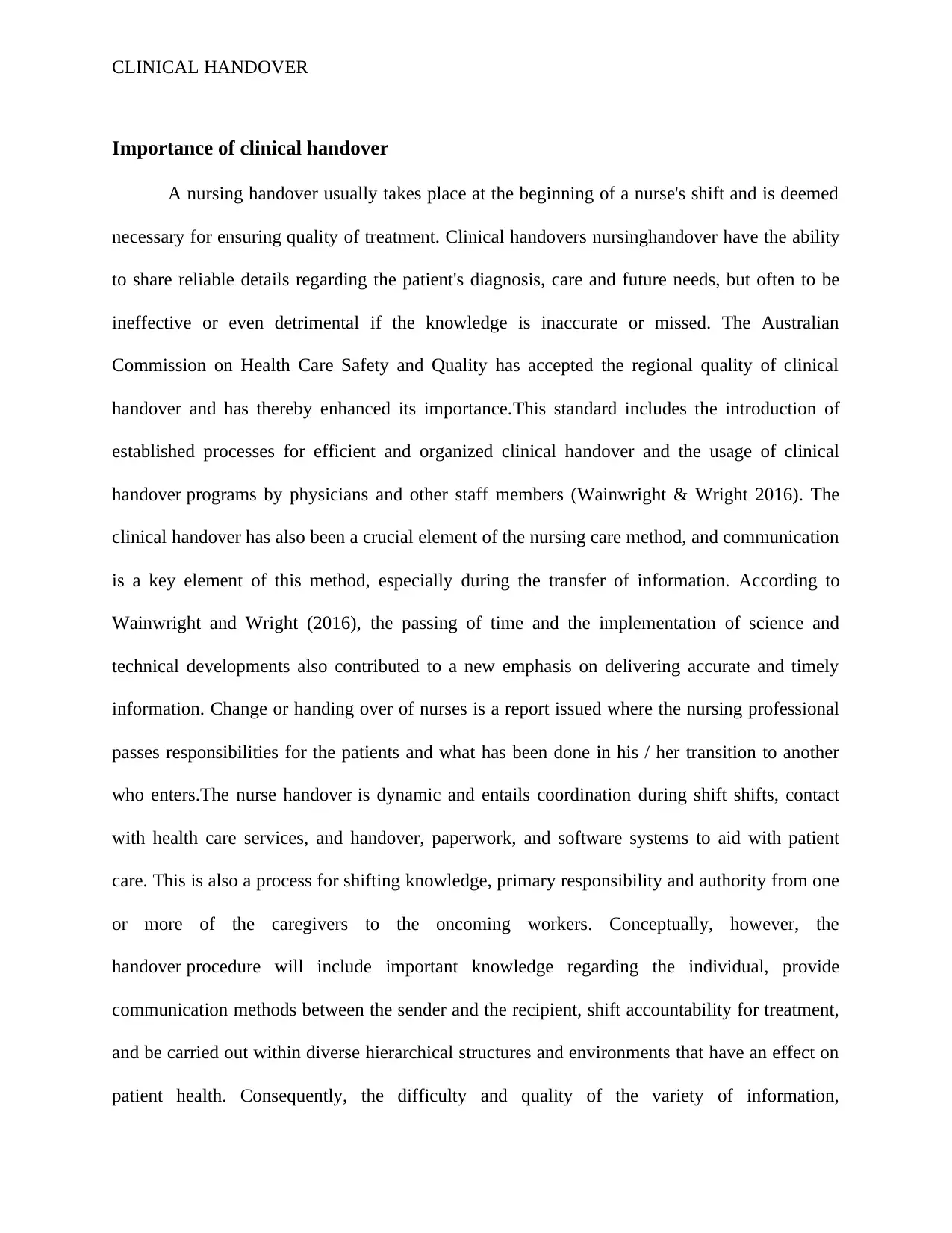
CLINICAL HANDOVER
Importance of clinical handover
A nursing handover usually takes place at the beginning of a nurse's shift and is deemed
necessary for ensuring quality of treatment. Clinical handovers nursinghandover have the ability
to share reliable details regarding the patient's diagnosis, care and future needs, but often to be
ineffective or even detrimental if the knowledge is inaccurate or missed. The Australian
Commission on Health Care Safety and Quality has accepted the regional quality of clinical
handover and has thereby enhanced its importance.This standard includes the introduction of
established processes for efficient and organized clinical handover and the usage of clinical
handover programs by physicians and other staff members (Wainwright & Wright 2016). The
clinical handover has also been a crucial element of the nursing care method, and communication
is a key element of this method, especially during the transfer of information. According to
Wainwright and Wright (2016), the passing of time and the implementation of science and
technical developments also contributed to a new emphasis on delivering accurate and timely
information. Change or handing over of nurses is a report issued where the nursing professional
passes responsibilities for the patients and what has been done in his / her transition to another
who enters.The nurse handover is dynamic and entails coordination during shift shifts, contact
with health care services, and handover, paperwork, and software systems to aid with patient
care. This is also a process for shifting knowledge, primary responsibility and authority from one
or more of the caregivers to the oncoming workers. Conceptually, however, the
handover procedure will include important knowledge regarding the individual, provide
communication methods between the sender and the recipient, shift accountability for treatment,
and be carried out within diverse hierarchical structures and environments that have an effect on
patient health. Consequently, the difficulty and quality of the variety of information,
Importance of clinical handover
A nursing handover usually takes place at the beginning of a nurse's shift and is deemed
necessary for ensuring quality of treatment. Clinical handovers nursinghandover have the ability
to share reliable details regarding the patient's diagnosis, care and future needs, but often to be
ineffective or even detrimental if the knowledge is inaccurate or missed. The Australian
Commission on Health Care Safety and Quality has accepted the regional quality of clinical
handover and has thereby enhanced its importance.This standard includes the introduction of
established processes for efficient and organized clinical handover and the usage of clinical
handover programs by physicians and other staff members (Wainwright & Wright 2016). The
clinical handover has also been a crucial element of the nursing care method, and communication
is a key element of this method, especially during the transfer of information. According to
Wainwright and Wright (2016), the passing of time and the implementation of science and
technical developments also contributed to a new emphasis on delivering accurate and timely
information. Change or handing over of nurses is a report issued where the nursing professional
passes responsibilities for the patients and what has been done in his / her transition to another
who enters.The nurse handover is dynamic and entails coordination during shift shifts, contact
with health care services, and handover, paperwork, and software systems to aid with patient
care. This is also a process for shifting knowledge, primary responsibility and authority from one
or more of the caregivers to the oncoming workers. Conceptually, however, the
handover procedure will include important knowledge regarding the individual, provide
communication methods between the sender and the recipient, shift accountability for treatment,
and be carried out within diverse hierarchical structures and environments that have an effect on
patient health. Consequently, the difficulty and quality of the variety of information,
⊘ This is a preview!⊘
Do you want full access?
Subscribe today to unlock all pages.

Trusted by 1+ million students worldwide
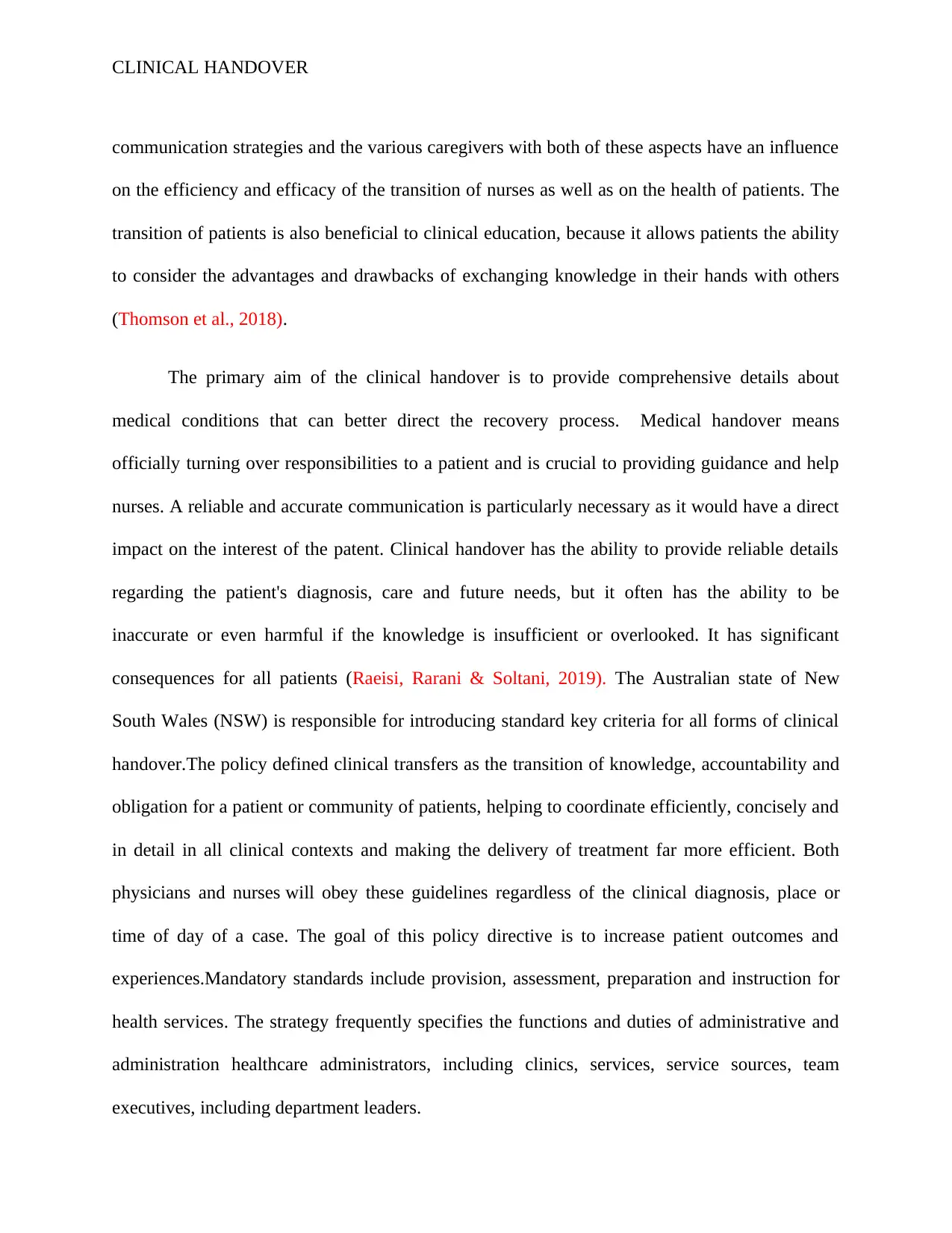
CLINICAL HANDOVER
communication strategies and the various caregivers with both of these aspects have an influence
on the efficiency and efficacy of the transition of nurses as well as on the health of patients. The
transition of patients is also beneficial to clinical education, because it allows patients the ability
to consider the advantages and drawbacks of exchanging knowledge in their hands with others
(Thomson et al., 2018).
The primary aim of the clinical handover is to provide comprehensive details about
medical conditions that can better direct the recovery process. Medical handover means
officially turning over responsibilities to a patient and is crucial to providing guidance and help
nurses. A reliable and accurate communication is particularly necessary as it would have a direct
impact on the interest of the patent. Clinical handover has the ability to provide reliable details
regarding the patient's diagnosis, care and future needs, but it often has the ability to be
inaccurate or even harmful if the knowledge is insufficient or overlooked. It has significant
consequences for all patients (Raeisi, Rarani & Soltani, 2019). The Australian state of New
South Wales (NSW) is responsible for introducing standard key criteria for all forms of clinical
handover.The policy defined clinical transfers as the transition of knowledge, accountability and
obligation for a patient or community of patients, helping to coordinate efficiently, concisely and
in detail in all clinical contexts and making the delivery of treatment far more efficient. Both
physicians and nurses will obey these guidelines regardless of the clinical diagnosis, place or
time of day of a case. The goal of this policy directive is to increase patient outcomes and
experiences.Mandatory standards include provision, assessment, preparation and instruction for
health services. The strategy frequently specifies the functions and duties of administrative and
administration healthcare administrators, including clinics, services, service sources, team
executives, including department leaders.
communication strategies and the various caregivers with both of these aspects have an influence
on the efficiency and efficacy of the transition of nurses as well as on the health of patients. The
transition of patients is also beneficial to clinical education, because it allows patients the ability
to consider the advantages and drawbacks of exchanging knowledge in their hands with others
(Thomson et al., 2018).
The primary aim of the clinical handover is to provide comprehensive details about
medical conditions that can better direct the recovery process. Medical handover means
officially turning over responsibilities to a patient and is crucial to providing guidance and help
nurses. A reliable and accurate communication is particularly necessary as it would have a direct
impact on the interest of the patent. Clinical handover has the ability to provide reliable details
regarding the patient's diagnosis, care and future needs, but it often has the ability to be
inaccurate or even harmful if the knowledge is insufficient or overlooked. It has significant
consequences for all patients (Raeisi, Rarani & Soltani, 2019). The Australian state of New
South Wales (NSW) is responsible for introducing standard key criteria for all forms of clinical
handover.The policy defined clinical transfers as the transition of knowledge, accountability and
obligation for a patient or community of patients, helping to coordinate efficiently, concisely and
in detail in all clinical contexts and making the delivery of treatment far more efficient. Both
physicians and nurses will obey these guidelines regardless of the clinical diagnosis, place or
time of day of a case. The goal of this policy directive is to increase patient outcomes and
experiences.Mandatory standards include provision, assessment, preparation and instruction for
health services. The strategy frequently specifies the functions and duties of administrative and
administration healthcare administrators, including clinics, services, service sources, team
executives, including department leaders.
Paraphrase This Document
Need a fresh take? Get an instant paraphrase of this document with our AI Paraphraser
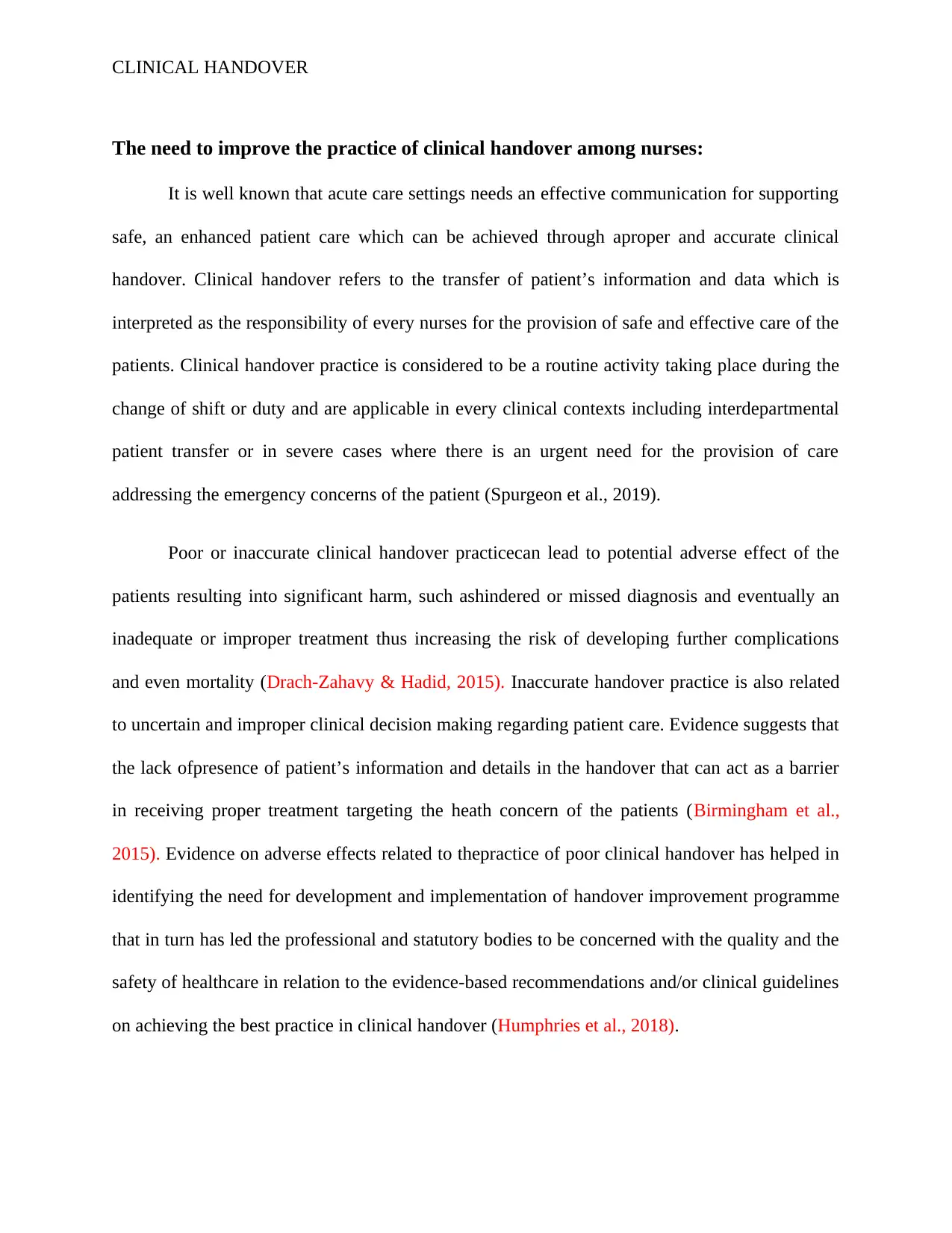
CLINICAL HANDOVER
The need to improve the practice of clinical handover among nurses:
It is well known that acute care settings needs an effective communication for supporting
safe, an enhanced patient care which can be achieved through aproper and accurate clinical
handover. Clinical handover refers to the transfer of patient’s information and data which is
interpreted as the responsibility of every nurses for the provision of safe and effective care of the
patients. Clinical handover practice is considered to be a routine activity taking place during the
change of shift or duty and are applicable in every clinical contexts including interdepartmental
patient transfer or in severe cases where there is an urgent need for the provision of care
addressing the emergency concerns of the patient (Spurgeon et al., 2019).
Poor or inaccurate clinical handover practicecan lead to potential adverse effect of the
patients resulting into significant harm, such ashindered or missed diagnosis and eventually an
inadequate or improper treatment thus increasing the risk of developing further complications
and even mortality (Drach‐Zahavy & Hadid, 2015). Inaccurate handover practice is also related
to uncertain and improper clinical decision making regarding patient care. Evidence suggests that
the lack ofpresence of patient’s information and details in the handover that can act as a barrier
in receiving proper treatment targeting the heath concern of the patients (Birmingham et al.,
2015). Evidence on adverse effects related to thepractice of poor clinical handover has helped in
identifying the need for development and implementation of handover improvement programme
that in turn has led the professional and statutory bodies to be concerned with the quality and the
safety of healthcare in relation to the evidence-based recommendations and/or clinical guidelines
on achieving the best practice in clinical handover (Humphries et al., 2018).
The need to improve the practice of clinical handover among nurses:
It is well known that acute care settings needs an effective communication for supporting
safe, an enhanced patient care which can be achieved through aproper and accurate clinical
handover. Clinical handover refers to the transfer of patient’s information and data which is
interpreted as the responsibility of every nurses for the provision of safe and effective care of the
patients. Clinical handover practice is considered to be a routine activity taking place during the
change of shift or duty and are applicable in every clinical contexts including interdepartmental
patient transfer or in severe cases where there is an urgent need for the provision of care
addressing the emergency concerns of the patient (Spurgeon et al., 2019).
Poor or inaccurate clinical handover practicecan lead to potential adverse effect of the
patients resulting into significant harm, such ashindered or missed diagnosis and eventually an
inadequate or improper treatment thus increasing the risk of developing further complications
and even mortality (Drach‐Zahavy & Hadid, 2015). Inaccurate handover practice is also related
to uncertain and improper clinical decision making regarding patient care. Evidence suggests that
the lack ofpresence of patient’s information and details in the handover that can act as a barrier
in receiving proper treatment targeting the heath concern of the patients (Birmingham et al.,
2015). Evidence on adverse effects related to thepractice of poor clinical handover has helped in
identifying the need for development and implementation of handover improvement programme
that in turn has led the professional and statutory bodies to be concerned with the quality and the
safety of healthcare in relation to the evidence-based recommendations and/or clinical guidelines
on achieving the best practice in clinical handover (Humphries et al., 2018).
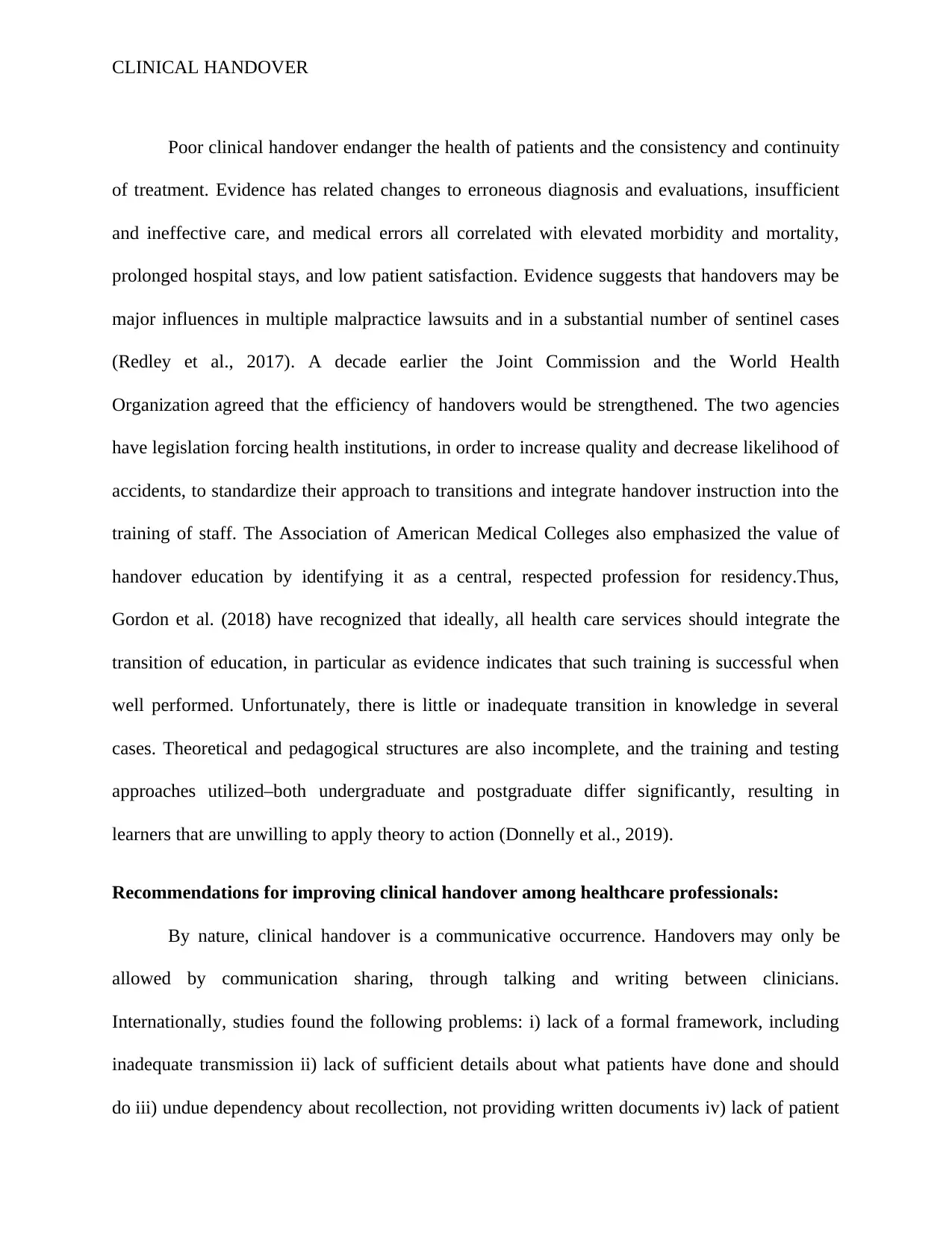
CLINICAL HANDOVER
Poor clinical handover endanger the health of patients and the consistency and continuity
of treatment. Evidence has related changes to erroneous diagnosis and evaluations, insufficient
and ineffective care, and medical errors all correlated with elevated morbidity and mortality,
prolonged hospital stays, and low patient satisfaction. Evidence suggests that handovers may be
major influences in multiple malpractice lawsuits and in a substantial number of sentinel cases
(Redley et al., 2017). A decade earlier the Joint Commission and the World Health
Organization agreed that the efficiency of handovers would be strengthened. The two agencies
have legislation forcing health institutions, in order to increase quality and decrease likelihood of
accidents, to standardize their approach to transitions and integrate handover instruction into the
training of staff. The Association of American Medical Colleges also emphasized the value of
handover education by identifying it as a central, respected profession for residency.Thus,
Gordon et al. (2018) have recognized that ideally, all health care services should integrate the
transition of education, in particular as evidence indicates that such training is successful when
well performed. Unfortunately, there is little or inadequate transition in knowledge in several
cases. Theoretical and pedagogical structures are also incomplete, and the training and testing
approaches utilized–both undergraduate and postgraduate differ significantly, resulting in
learners that are unwilling to apply theory to action (Donnelly et al., 2019).
Recommendations for improving clinical handover among healthcare professionals:
By nature, clinical handover is a communicative occurrence. Handovers may only be
allowed by communication sharing, through talking and writing between clinicians.
Internationally, studies found the following problems: i) lack of a formal framework, including
inadequate transmission ii) lack of sufficient details about what patients have done and should
do iii) undue dependency about recollection, not providing written documents iv) lack of patient
Poor clinical handover endanger the health of patients and the consistency and continuity
of treatment. Evidence has related changes to erroneous diagnosis and evaluations, insufficient
and ineffective care, and medical errors all correlated with elevated morbidity and mortality,
prolonged hospital stays, and low patient satisfaction. Evidence suggests that handovers may be
major influences in multiple malpractice lawsuits and in a substantial number of sentinel cases
(Redley et al., 2017). A decade earlier the Joint Commission and the World Health
Organization agreed that the efficiency of handovers would be strengthened. The two agencies
have legislation forcing health institutions, in order to increase quality and decrease likelihood of
accidents, to standardize their approach to transitions and integrate handover instruction into the
training of staff. The Association of American Medical Colleges also emphasized the value of
handover education by identifying it as a central, respected profession for residency.Thus,
Gordon et al. (2018) have recognized that ideally, all health care services should integrate the
transition of education, in particular as evidence indicates that such training is successful when
well performed. Unfortunately, there is little or inadequate transition in knowledge in several
cases. Theoretical and pedagogical structures are also incomplete, and the training and testing
approaches utilized–both undergraduate and postgraduate differ significantly, resulting in
learners that are unwilling to apply theory to action (Donnelly et al., 2019).
Recommendations for improving clinical handover among healthcare professionals:
By nature, clinical handover is a communicative occurrence. Handovers may only be
allowed by communication sharing, through talking and writing between clinicians.
Internationally, studies found the following problems: i) lack of a formal framework, including
inadequate transmission ii) lack of sufficient details about what patients have done and should
do iii) undue dependency about recollection, not providing written documents iv) lack of patient
⊘ This is a preview!⊘
Do you want full access?
Subscribe today to unlock all pages.

Trusted by 1+ million students worldwide
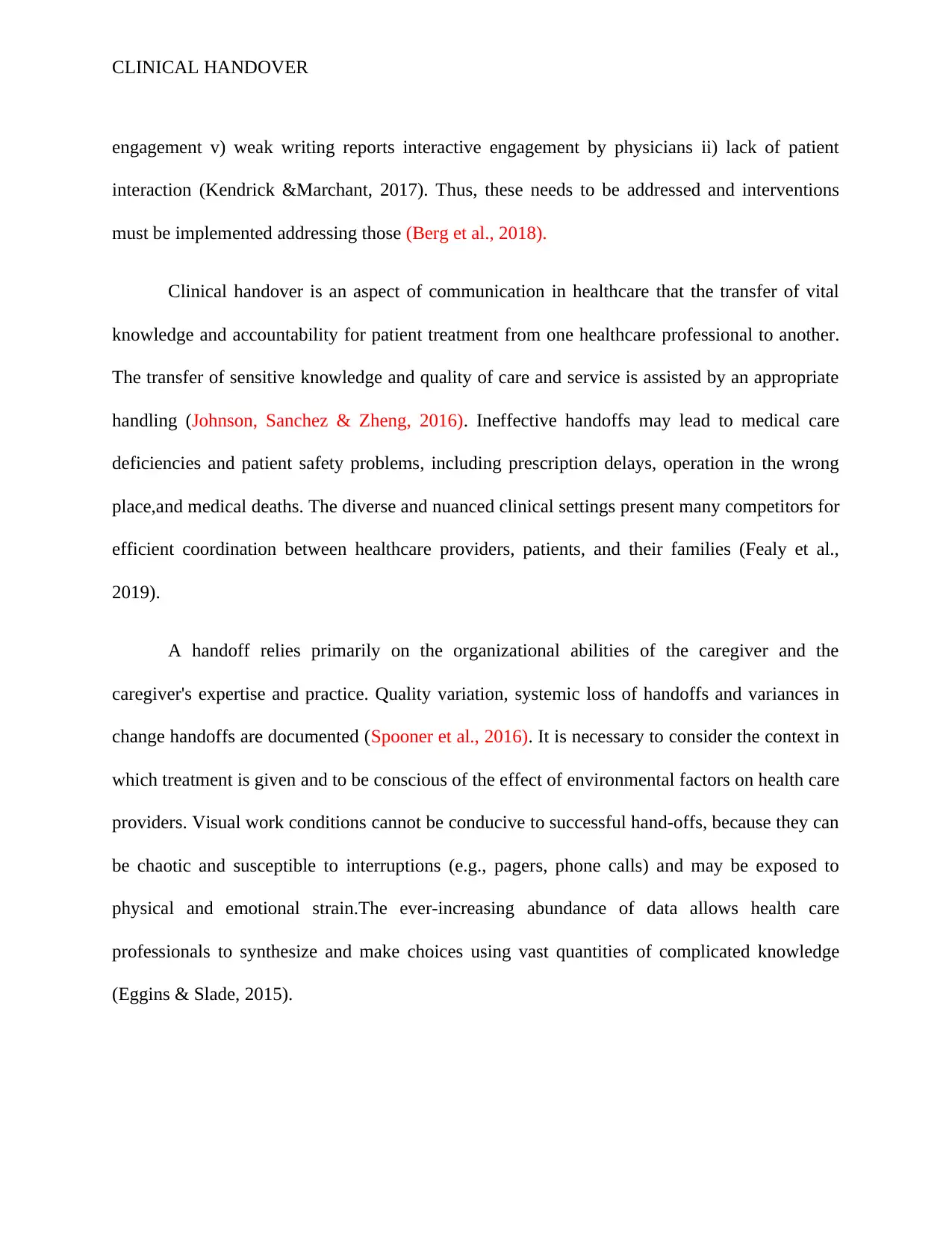
CLINICAL HANDOVER
engagement v) weak writing reports interactive engagement by physicians ii) lack of patient
interaction (Kendrick &Marchant, 2017). Thus, these needs to be addressed and interventions
must be implemented addressing those (Berg et al., 2018).
Clinical handover is an aspect of communication in healthcare that the transfer of vital
knowledge and accountability for patient treatment from one healthcare professional to another.
The transfer of sensitive knowledge and quality of care and service is assisted by an appropriate
handling (Johnson, Sanchez & Zheng, 2016). Ineffective handoffs may lead to medical care
deficiencies and patient safety problems, including prescription delays, operation in the wrong
place,and medical deaths. The diverse and nuanced clinical settings present many competitors for
efficient coordination between healthcare providers, patients, and their families (Fealy et al.,
2019).
A handoff relies primarily on the organizational abilities of the caregiver and the
caregiver's expertise and practice. Quality variation, systemic loss of handoffs and variances in
change handoffs are documented (Spooner et al., 2016). It is necessary to consider the context in
which treatment is given and to be conscious of the effect of environmental factors on health care
providers. Visual work conditions cannot be conducive to successful hand-offs, because they can
be chaotic and susceptible to interruptions (e.g., pagers, phone calls) and may be exposed to
physical and emotional strain.The ever-increasing abundance of data allows health care
professionals to synthesize and make choices using vast quantities of complicated knowledge
(Eggins & Slade, 2015).
engagement v) weak writing reports interactive engagement by physicians ii) lack of patient
interaction (Kendrick &Marchant, 2017). Thus, these needs to be addressed and interventions
must be implemented addressing those (Berg et al., 2018).
Clinical handover is an aspect of communication in healthcare that the transfer of vital
knowledge and accountability for patient treatment from one healthcare professional to another.
The transfer of sensitive knowledge and quality of care and service is assisted by an appropriate
handling (Johnson, Sanchez & Zheng, 2016). Ineffective handoffs may lead to medical care
deficiencies and patient safety problems, including prescription delays, operation in the wrong
place,and medical deaths. The diverse and nuanced clinical settings present many competitors for
efficient coordination between healthcare providers, patients, and their families (Fealy et al.,
2019).
A handoff relies primarily on the organizational abilities of the caregiver and the
caregiver's expertise and practice. Quality variation, systemic loss of handoffs and variances in
change handoffs are documented (Spooner et al., 2016). It is necessary to consider the context in
which treatment is given and to be conscious of the effect of environmental factors on health care
providers. Visual work conditions cannot be conducive to successful hand-offs, because they can
be chaotic and susceptible to interruptions (e.g., pagers, phone calls) and may be exposed to
physical and emotional strain.The ever-increasing abundance of data allows health care
professionals to synthesize and make choices using vast quantities of complicated knowledge
(Eggins & Slade, 2015).
Paraphrase This Document
Need a fresh take? Get an instant paraphrase of this document with our AI Paraphraser
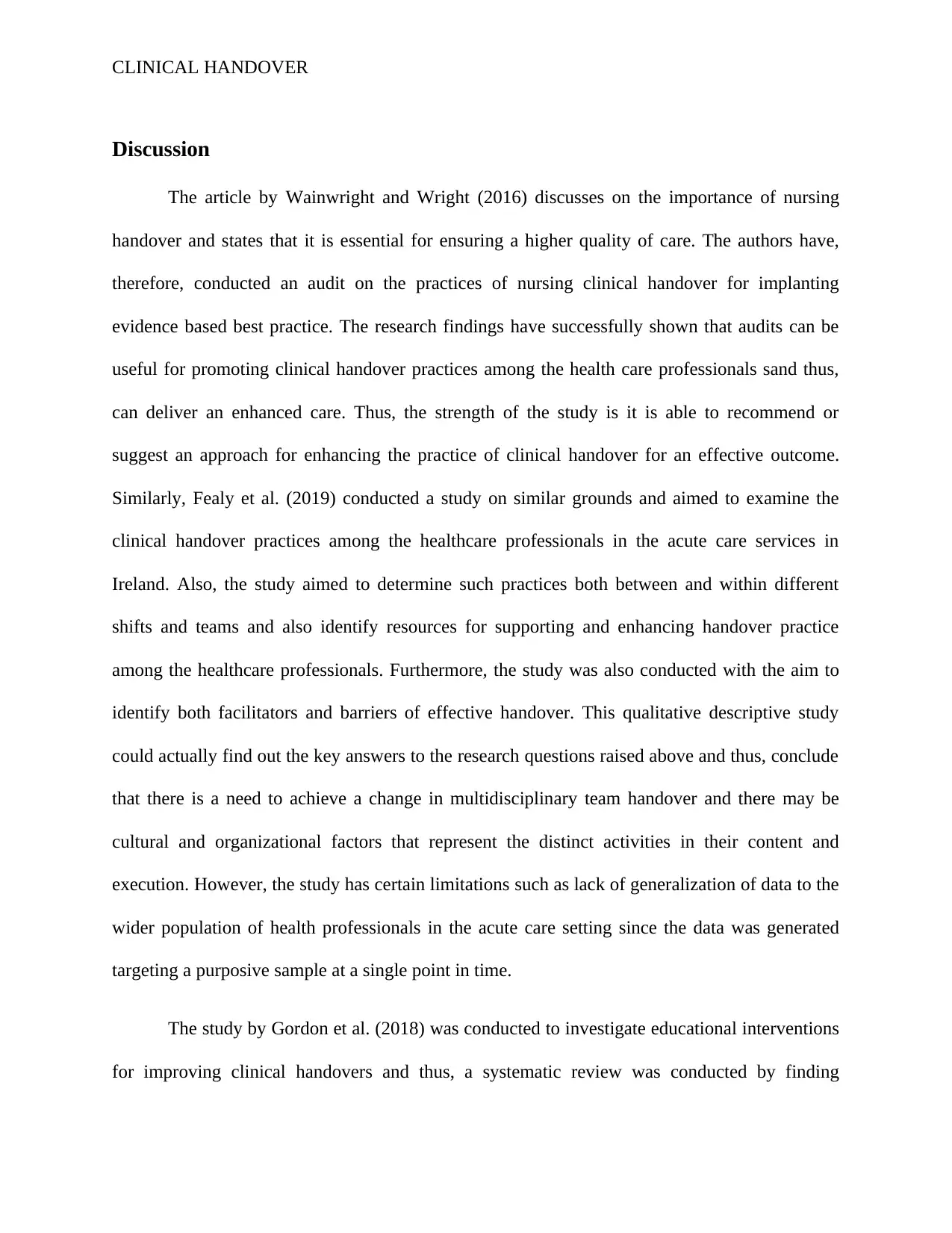
CLINICAL HANDOVER
Discussion
The article by Wainwright and Wright (2016) discusses on the importance of nursing
handover and states that it is essential for ensuring a higher quality of care. The authors have,
therefore, conducted an audit on the practices of nursing clinical handover for implanting
evidence based best practice. The research findings have successfully shown that audits can be
useful for promoting clinical handover practices among the health care professionals sand thus,
can deliver an enhanced care. Thus, the strength of the study is it is able to recommend or
suggest an approach for enhancing the practice of clinical handover for an effective outcome.
Similarly, Fealy et al. (2019) conducted a study on similar grounds and aimed to examine the
clinical handover practices among the healthcare professionals in the acute care services in
Ireland. Also, the study aimed to determine such practices both between and within different
shifts and teams and also identify resources for supporting and enhancing handover practice
among the healthcare professionals. Furthermore, the study was also conducted with the aim to
identify both facilitators and barriers of effective handover. This qualitative descriptive study
could actually find out the key answers to the research questions raised above and thus, conclude
that there is a need to achieve a change in multidisciplinary team handover and there may be
cultural and organizational factors that represent the distinct activities in their content and
execution. However, the study has certain limitations such as lack of generalization of data to the
wider population of health professionals in the acute care setting since the data was generated
targeting a purposive sample at a single point in time.
The study by Gordon et al. (2018) was conducted to investigate educational interventions
for improving clinical handovers and thus, a systematic review was conducted by finding
Discussion
The article by Wainwright and Wright (2016) discusses on the importance of nursing
handover and states that it is essential for ensuring a higher quality of care. The authors have,
therefore, conducted an audit on the practices of nursing clinical handover for implanting
evidence based best practice. The research findings have successfully shown that audits can be
useful for promoting clinical handover practices among the health care professionals sand thus,
can deliver an enhanced care. Thus, the strength of the study is it is able to recommend or
suggest an approach for enhancing the practice of clinical handover for an effective outcome.
Similarly, Fealy et al. (2019) conducted a study on similar grounds and aimed to examine the
clinical handover practices among the healthcare professionals in the acute care services in
Ireland. Also, the study aimed to determine such practices both between and within different
shifts and teams and also identify resources for supporting and enhancing handover practice
among the healthcare professionals. Furthermore, the study was also conducted with the aim to
identify both facilitators and barriers of effective handover. This qualitative descriptive study
could actually find out the key answers to the research questions raised above and thus, conclude
that there is a need to achieve a change in multidisciplinary team handover and there may be
cultural and organizational factors that represent the distinct activities in their content and
execution. However, the study has certain limitations such as lack of generalization of data to the
wider population of health professionals in the acute care setting since the data was generated
targeting a purposive sample at a single point in time.
The study by Gordon et al. (2018) was conducted to investigate educational interventions
for improving clinical handovers and thus, a systematic review was conducted by finding
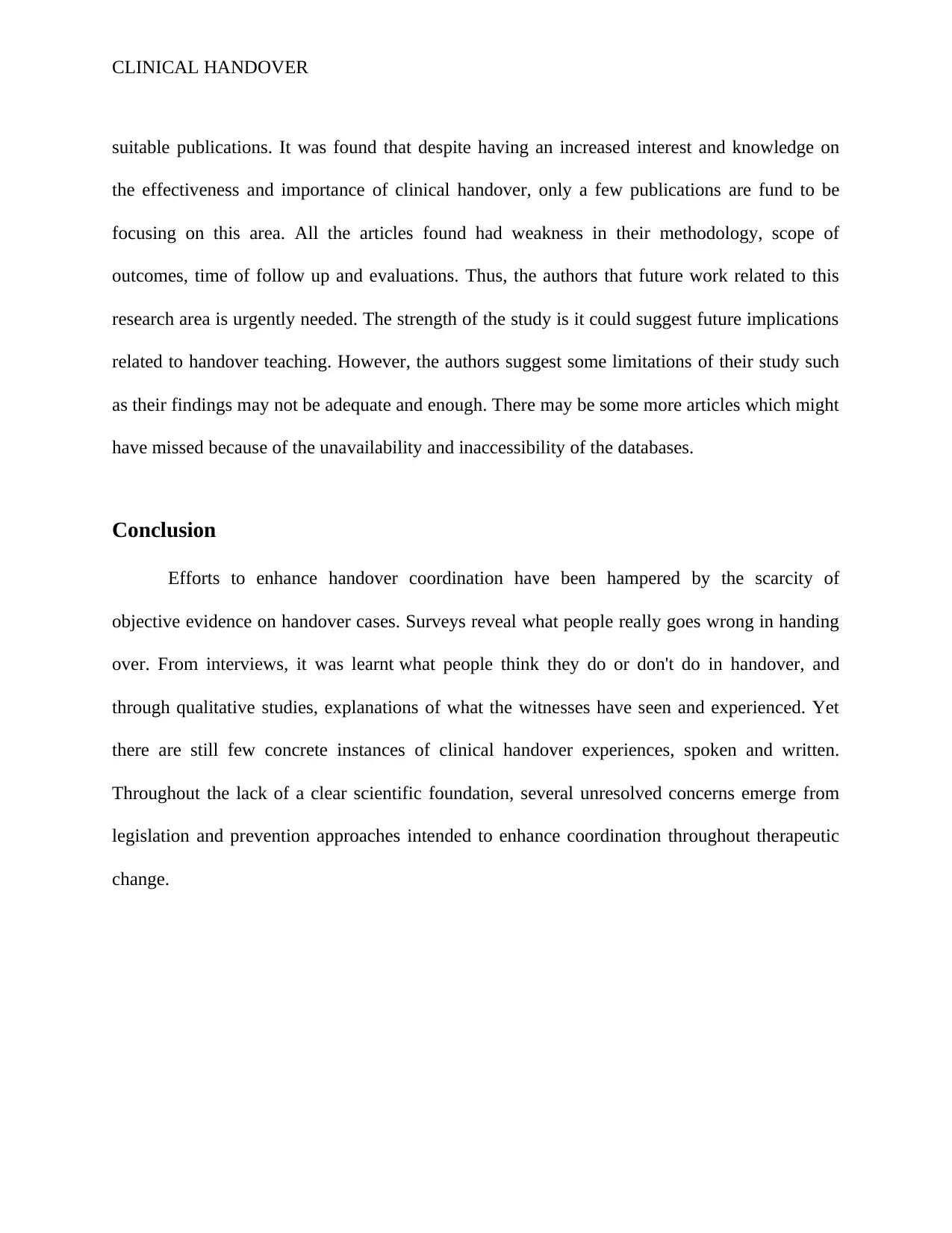
CLINICAL HANDOVER
suitable publications. It was found that despite having an increased interest and knowledge on
the effectiveness and importance of clinical handover, only a few publications are fund to be
focusing on this area. All the articles found had weakness in their methodology, scope of
outcomes, time of follow up and evaluations. Thus, the authors that future work related to this
research area is urgently needed. The strength of the study is it could suggest future implications
related to handover teaching. However, the authors suggest some limitations of their study such
as their findings may not be adequate and enough. There may be some more articles which might
have missed because of the unavailability and inaccessibility of the databases.
Conclusion
Efforts to enhance handover coordination have been hampered by the scarcity of
objective evidence on handover cases. Surveys reveal what people really goes wrong in handing
over. From interviews, it was learnt what people think they do or don't do in handover, and
through qualitative studies, explanations of what the witnesses have seen and experienced. Yet
there are still few concrete instances of clinical handover experiences, spoken and written.
Throughout the lack of a clear scientific foundation, several unresolved concerns emerge from
legislation and prevention approaches intended to enhance coordination throughout therapeutic
change.
suitable publications. It was found that despite having an increased interest and knowledge on
the effectiveness and importance of clinical handover, only a few publications are fund to be
focusing on this area. All the articles found had weakness in their methodology, scope of
outcomes, time of follow up and evaluations. Thus, the authors that future work related to this
research area is urgently needed. The strength of the study is it could suggest future implications
related to handover teaching. However, the authors suggest some limitations of their study such
as their findings may not be adequate and enough. There may be some more articles which might
have missed because of the unavailability and inaccessibility of the databases.
Conclusion
Efforts to enhance handover coordination have been hampered by the scarcity of
objective evidence on handover cases. Surveys reveal what people really goes wrong in handing
over. From interviews, it was learnt what people think they do or don't do in handover, and
through qualitative studies, explanations of what the witnesses have seen and experienced. Yet
there are still few concrete instances of clinical handover experiences, spoken and written.
Throughout the lack of a clear scientific foundation, several unresolved concerns emerge from
legislation and prevention approaches intended to enhance coordination throughout therapeutic
change.
⊘ This is a preview!⊘
Do you want full access?
Subscribe today to unlock all pages.

Trusted by 1+ million students worldwide
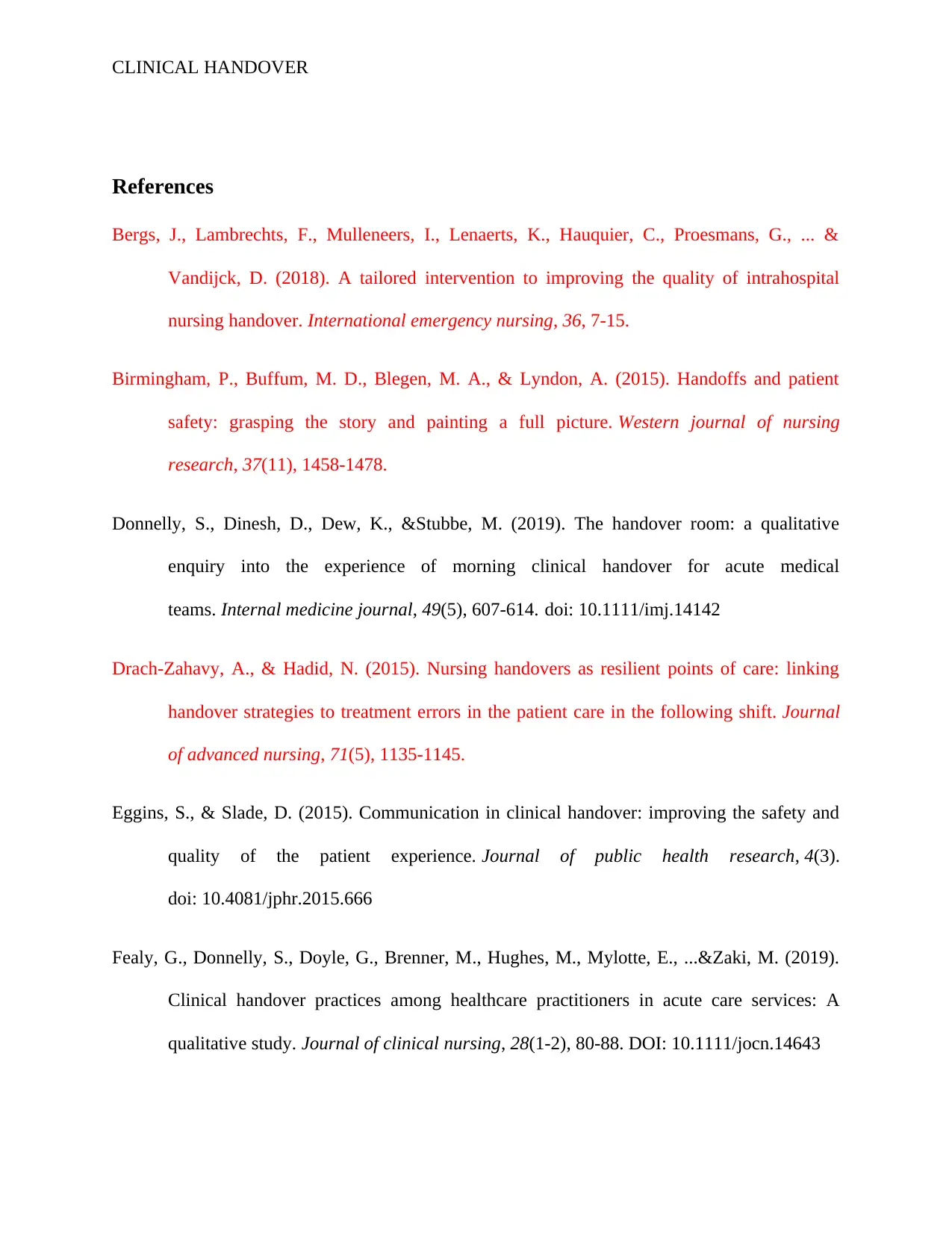
CLINICAL HANDOVER
References
Bergs, J., Lambrechts, F., Mulleneers, I., Lenaerts, K., Hauquier, C., Proesmans, G., ... &
Vandijck, D. (2018). A tailored intervention to improving the quality of intrahospital
nursing handover. International emergency nursing, 36, 7-15.
Birmingham, P., Buffum, M. D., Blegen, M. A., & Lyndon, A. (2015). Handoffs and patient
safety: grasping the story and painting a full picture. Western journal of nursing
research, 37(11), 1458-1478.
Donnelly, S., Dinesh, D., Dew, K., &Stubbe, M. (2019). The handover room: a qualitative
enquiry into the experience of morning clinical handover for acute medical
teams. Internal medicine journal, 49(5), 607-614. doi: 10.1111/imj.14142
Drach‐Zahavy, A., & Hadid, N. (2015). Nursing handovers as resilient points of care: linking
handover strategies to treatment errors in the patient care in the following shift. Journal
of advanced nursing, 71(5), 1135-1145.
Eggins, S., & Slade, D. (2015). Communication in clinical handover: improving the safety and
quality of the patient experience. Journal of public health research, 4(3).
doi: 10.4081/jphr.2015.666
Fealy, G., Donnelly, S., Doyle, G., Brenner, M., Hughes, M., Mylotte, E., ...&Zaki, M. (2019).
Clinical handover practices among healthcare practitioners in acute care services: A
qualitative study. Journal of clinical nursing, 28(1-2), 80-88. DOI: 10.1111/jocn.14643
References
Bergs, J., Lambrechts, F., Mulleneers, I., Lenaerts, K., Hauquier, C., Proesmans, G., ... &
Vandijck, D. (2018). A tailored intervention to improving the quality of intrahospital
nursing handover. International emergency nursing, 36, 7-15.
Birmingham, P., Buffum, M. D., Blegen, M. A., & Lyndon, A. (2015). Handoffs and patient
safety: grasping the story and painting a full picture. Western journal of nursing
research, 37(11), 1458-1478.
Donnelly, S., Dinesh, D., Dew, K., &Stubbe, M. (2019). The handover room: a qualitative
enquiry into the experience of morning clinical handover for acute medical
teams. Internal medicine journal, 49(5), 607-614. doi: 10.1111/imj.14142
Drach‐Zahavy, A., & Hadid, N. (2015). Nursing handovers as resilient points of care: linking
handover strategies to treatment errors in the patient care in the following shift. Journal
of advanced nursing, 71(5), 1135-1145.
Eggins, S., & Slade, D. (2015). Communication in clinical handover: improving the safety and
quality of the patient experience. Journal of public health research, 4(3).
doi: 10.4081/jphr.2015.666
Fealy, G., Donnelly, S., Doyle, G., Brenner, M., Hughes, M., Mylotte, E., ...&Zaki, M. (2019).
Clinical handover practices among healthcare practitioners in acute care services: A
qualitative study. Journal of clinical nursing, 28(1-2), 80-88. DOI: 10.1111/jocn.14643
Paraphrase This Document
Need a fresh take? Get an instant paraphrase of this document with our AI Paraphraser
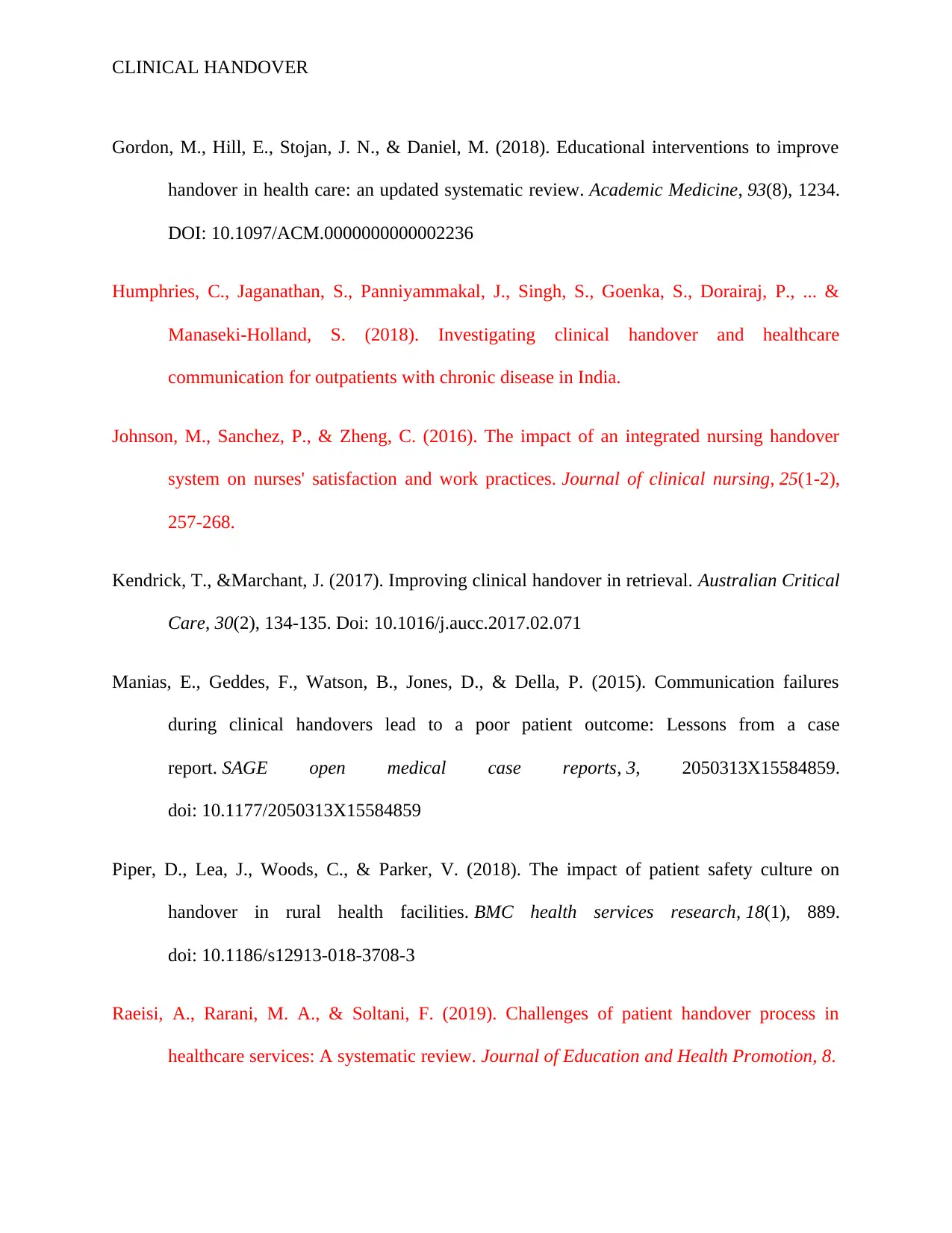
CLINICAL HANDOVER
Gordon, M., Hill, E., Stojan, J. N., & Daniel, M. (2018). Educational interventions to improve
handover in health care: an updated systematic review. Academic Medicine, 93(8), 1234.
DOI: 10.1097/ACM.0000000000002236
Humphries, C., Jaganathan, S., Panniyammakal, J., Singh, S., Goenka, S., Dorairaj, P., ... &
Manaseki-Holland, S. (2018). Investigating clinical handover and healthcare
communication for outpatients with chronic disease in India.
Johnson, M., Sanchez, P., & Zheng, C. (2016). The impact of an integrated nursing handover
system on nurses' satisfaction and work practices. Journal of clinical nursing, 25(1-2),
257-268.
Kendrick, T., &Marchant, J. (2017). Improving clinical handover in retrieval. Australian Critical
Care, 30(2), 134-135. Doi: 10.1016/j.aucc.2017.02.071
Manias, E., Geddes, F., Watson, B., Jones, D., & Della, P. (2015). Communication failures
during clinical handovers lead to a poor patient outcome: Lessons from a case
report. SAGE open medical case reports, 3, 2050313X15584859.
doi: 10.1177/2050313X15584859
Piper, D., Lea, J., Woods, C., & Parker, V. (2018). The impact of patient safety culture on
handover in rural health facilities. BMC health services research, 18(1), 889.
doi: 10.1186/s12913-018-3708-3
Raeisi, A., Rarani, M. A., & Soltani, F. (2019). Challenges of patient handover process in
healthcare services: A systematic review. Journal of Education and Health Promotion, 8.
Gordon, M., Hill, E., Stojan, J. N., & Daniel, M. (2018). Educational interventions to improve
handover in health care: an updated systematic review. Academic Medicine, 93(8), 1234.
DOI: 10.1097/ACM.0000000000002236
Humphries, C., Jaganathan, S., Panniyammakal, J., Singh, S., Goenka, S., Dorairaj, P., ... &
Manaseki-Holland, S. (2018). Investigating clinical handover and healthcare
communication for outpatients with chronic disease in India.
Johnson, M., Sanchez, P., & Zheng, C. (2016). The impact of an integrated nursing handover
system on nurses' satisfaction and work practices. Journal of clinical nursing, 25(1-2),
257-268.
Kendrick, T., &Marchant, J. (2017). Improving clinical handover in retrieval. Australian Critical
Care, 30(2), 134-135. Doi: 10.1016/j.aucc.2017.02.071
Manias, E., Geddes, F., Watson, B., Jones, D., & Della, P. (2015). Communication failures
during clinical handovers lead to a poor patient outcome: Lessons from a case
report. SAGE open medical case reports, 3, 2050313X15584859.
doi: 10.1177/2050313X15584859
Piper, D., Lea, J., Woods, C., & Parker, V. (2018). The impact of patient safety culture on
handover in rural health facilities. BMC health services research, 18(1), 889.
doi: 10.1186/s12913-018-3708-3
Raeisi, A., Rarani, M. A., & Soltani, F. (2019). Challenges of patient handover process in
healthcare services: A systematic review. Journal of Education and Health Promotion, 8.
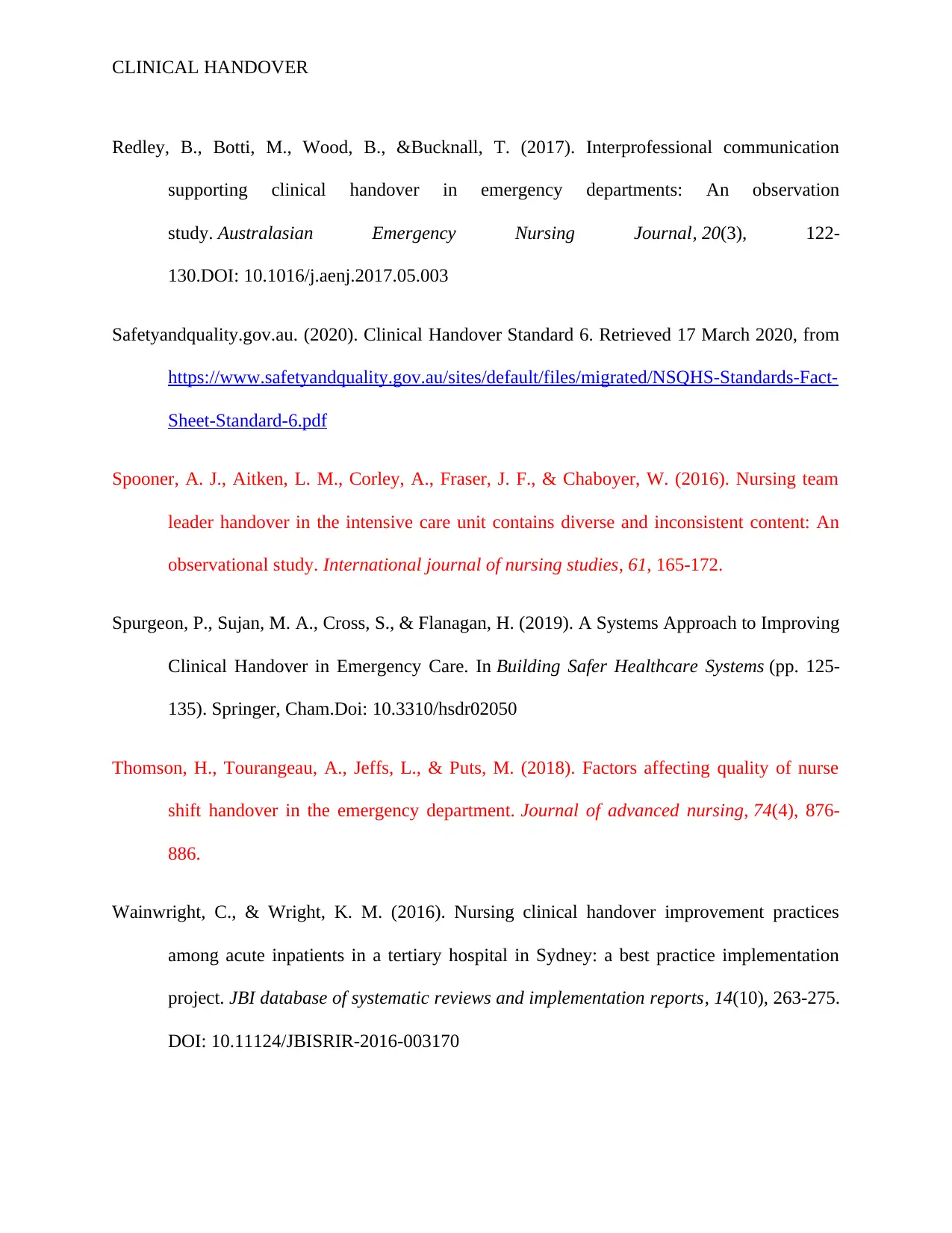
CLINICAL HANDOVER
Redley, B., Botti, M., Wood, B., &Bucknall, T. (2017). Interprofessional communication
supporting clinical handover in emergency departments: An observation
study. Australasian Emergency Nursing Journal, 20(3), 122-
130.DOI: 10.1016/j.aenj.2017.05.003
Safetyandquality.gov.au. (2020). Clinical Handover Standard 6. Retrieved 17 March 2020, from
https://www.safetyandquality.gov.au/sites/default/files/migrated/NSQHS-Standards-Fact-
Sheet-Standard-6.pdf
Spooner, A. J., Aitken, L. M., Corley, A., Fraser, J. F., & Chaboyer, W. (2016). Nursing team
leader handover in the intensive care unit contains diverse and inconsistent content: An
observational study. International journal of nursing studies, 61, 165-172.
Spurgeon, P., Sujan, M. A., Cross, S., & Flanagan, H. (2019). A Systems Approach to Improving
Clinical Handover in Emergency Care. In Building Safer Healthcare Systems (pp. 125-
135). Springer, Cham.Doi: 10.3310/hsdr02050
Thomson, H., Tourangeau, A., Jeffs, L., & Puts, M. (2018). Factors affecting quality of nurse
shift handover in the emergency department. Journal of advanced nursing, 74(4), 876-
886.
Wainwright, C., & Wright, K. M. (2016). Nursing clinical handover improvement practices
among acute inpatients in a tertiary hospital in Sydney: a best practice implementation
project. JBI database of systematic reviews and implementation reports, 14(10), 263-275.
DOI: 10.11124/JBISRIR-2016-003170
Redley, B., Botti, M., Wood, B., &Bucknall, T. (2017). Interprofessional communication
supporting clinical handover in emergency departments: An observation
study. Australasian Emergency Nursing Journal, 20(3), 122-
130.DOI: 10.1016/j.aenj.2017.05.003
Safetyandquality.gov.au. (2020). Clinical Handover Standard 6. Retrieved 17 March 2020, from
https://www.safetyandquality.gov.au/sites/default/files/migrated/NSQHS-Standards-Fact-
Sheet-Standard-6.pdf
Spooner, A. J., Aitken, L. M., Corley, A., Fraser, J. F., & Chaboyer, W. (2016). Nursing team
leader handover in the intensive care unit contains diverse and inconsistent content: An
observational study. International journal of nursing studies, 61, 165-172.
Spurgeon, P., Sujan, M. A., Cross, S., & Flanagan, H. (2019). A Systems Approach to Improving
Clinical Handover in Emergency Care. In Building Safer Healthcare Systems (pp. 125-
135). Springer, Cham.Doi: 10.3310/hsdr02050
Thomson, H., Tourangeau, A., Jeffs, L., & Puts, M. (2018). Factors affecting quality of nurse
shift handover in the emergency department. Journal of advanced nursing, 74(4), 876-
886.
Wainwright, C., & Wright, K. M. (2016). Nursing clinical handover improvement practices
among acute inpatients in a tertiary hospital in Sydney: a best practice implementation
project. JBI database of systematic reviews and implementation reports, 14(10), 263-275.
DOI: 10.11124/JBISRIR-2016-003170
⊘ This is a preview!⊘
Do you want full access?
Subscribe today to unlock all pages.

Trusted by 1+ million students worldwide
1 out of 13
Related Documents
Your All-in-One AI-Powered Toolkit for Academic Success.
+13062052269
info@desklib.com
Available 24*7 on WhatsApp / Email
![[object Object]](/_next/static/media/star-bottom.7253800d.svg)
Unlock your academic potential
Copyright © 2020–2025 A2Z Services. All Rights Reserved. Developed and managed by ZUCOL.





